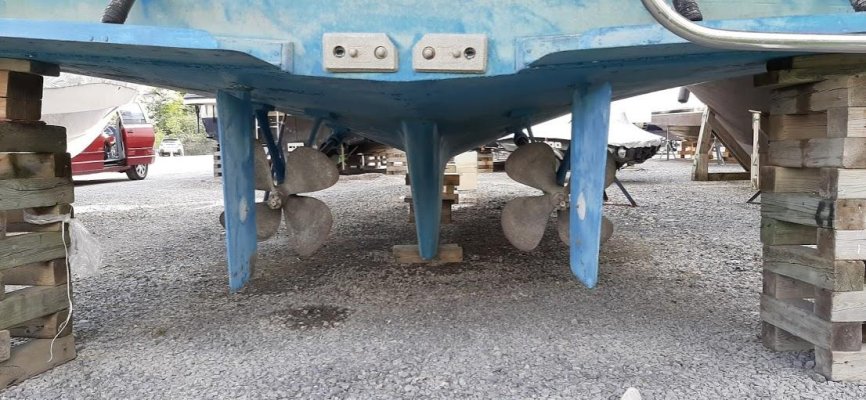CPD
Veteran Member
Do we have a propulsion problem we should be searching for - or perhaps the speeds we achieve is just the characteristic of our trawler?
Two summers now with our 1989 36ft Heritage East sundeck trawler, pair of turbo 150HP Volvo diesels (TMD41A), and we haven't hit theoretical hull speed yet...
With a water line of about 33 feet, theoretical hull speed is a little more than 7.5 knots.
Reading various posts I am curious and concerned than many suggest they achieve hull speed with as little as 2000 RPM, plus or minus.
With our two summers of experience, we achieve about 5 knots at 1600-1800 RPM, 6 knots in the 2200RPM area, and need 2800RPM or more for 7 knots. Wide Open Throttle is 3800RPM according to Volvo (we have yet to push above 3000RPM).
On the other hand, cruising almost always in the 5-6 knot range, we have averaged 1 gallon per hour per engine; so approximately 1/2 gallon per NM which appears respectable with respect to other posts.
A found internet quote: "For displacement hulls of reasonable shape (not a square box, which would require more power, and not a rowing shell used for competition, using less power), about 1 horsepower per long ton (2200lb) of displacement will get the boat to hull speed in calm water."
Assuming our trawler is 30,000 lb (14 Long Tons max), we should be seeing hull speed at 14HP, or somewhat more for inefficiencies. Volvo's TMD41A engine curves state 50HP crankshaft power should be produced at 1500 RPM, 75 crankshaft HP at 2000 RPM, and 120 crankshaft HP at 2500 RPM. If the HP per Long Ton is even roughly accurate, we should be hitting hull speed well before 2000RPM?
Cognizant of the large variety of (full displacement) trawlers and engines in this Forum, is your experience that theoretical hull speed should be achieved at something significantly below Wide Open Throttle?
(1) When we purchased the boat the mechanical inspection recommended overhaul of the 6 Injectors in each engine (exhaust colour may be indicating incomplete burn).
(2) I bought a Tach Reader and will check the accuracy of the RPM gauges in the spring.
(3) Given an average fuel burn of 2 gallons/hour is respectable, this isn't necessarily an issue I want to go to great mechanical expense to investigate (such as experimenting with propellers), but with a plan to do the Great Loop in 2 years it would be nice to know we can easily achieve hull speed when a situation requires.
Two summers now with our 1989 36ft Heritage East sundeck trawler, pair of turbo 150HP Volvo diesels (TMD41A), and we haven't hit theoretical hull speed yet...
With a water line of about 33 feet, theoretical hull speed is a little more than 7.5 knots.
Reading various posts I am curious and concerned than many suggest they achieve hull speed with as little as 2000 RPM, plus or minus.
With our two summers of experience, we achieve about 5 knots at 1600-1800 RPM, 6 knots in the 2200RPM area, and need 2800RPM or more for 7 knots. Wide Open Throttle is 3800RPM according to Volvo (we have yet to push above 3000RPM).
On the other hand, cruising almost always in the 5-6 knot range, we have averaged 1 gallon per hour per engine; so approximately 1/2 gallon per NM which appears respectable with respect to other posts.
A found internet quote: "For displacement hulls of reasonable shape (not a square box, which would require more power, and not a rowing shell used for competition, using less power), about 1 horsepower per long ton (2200lb) of displacement will get the boat to hull speed in calm water."
Assuming our trawler is 30,000 lb (14 Long Tons max), we should be seeing hull speed at 14HP, or somewhat more for inefficiencies. Volvo's TMD41A engine curves state 50HP crankshaft power should be produced at 1500 RPM, 75 crankshaft HP at 2000 RPM, and 120 crankshaft HP at 2500 RPM. If the HP per Long Ton is even roughly accurate, we should be hitting hull speed well before 2000RPM?
Cognizant of the large variety of (full displacement) trawlers and engines in this Forum, is your experience that theoretical hull speed should be achieved at something significantly below Wide Open Throttle?
(1) When we purchased the boat the mechanical inspection recommended overhaul of the 6 Injectors in each engine (exhaust colour may be indicating incomplete burn).
(2) I bought a Tach Reader and will check the accuracy of the RPM gauges in the spring.
(3) Given an average fuel burn of 2 gallons/hour is respectable, this isn't necessarily an issue I want to go to great mechanical expense to investigate (such as experimenting with propellers), but with a plan to do the Great Loop in 2 years it would be nice to know we can easily achieve hull speed when a situation requires.

